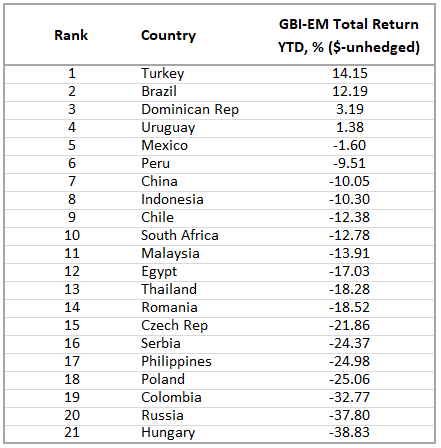Peak Rates – Mind the Fiscal Gap
October 26, 2022
Read Time 2 MIN
The End of EM Tightening Cycles
Tomorrow’s European Central Bank (ECB) rate-setting meeting will be the focal point of the week. A 75bps hike and the terminal rate of 3% are firmly in the price, but the press-conference and guidance will be equally important - both for interest rates (including the shape of the yield curve) and the euro, which staged a mini rally in the past few days. In emerging markets (EM), all eyes are on Brazil, where the central bank is expected to begin its next chapter by keeping the policy rate on hold this afternoon at 13.75%. The central bank’s pro-active response created a huge policy cushion (Brazil’s ex-ante real policy rate is around 8%!) that provided the fundamental support for the currency and local debt this year. The year-to-date total return on the J.P. Morgan’s GBI-EM Brazil Index (U.S. Dollar unhedged) is not just positive, but head and shoulders above the rest (except Turkey – see chart below). However, whether or not this outperformance can be extended going forward will also depend on the outcome of Sunday’s runoff (polls show a technical tie) and its impact on the policy agenda - especially on the fiscal front, where Brazil performed admirably in 2022.
South Africa Fiscal Adjustment
The market is also closely watching the pace of fiscal adjustment in South Africa, where the central bank (SARB) is still catching up with the rest of the EM pack. The SARB delivered two large 75bps hikes in a row, bringing the policy rate to 6.25%, and the just-released medium-term budget projections – especially smaller deficits - should ease the pressure to continue with aggressive hikes. The main concern, as usual, is about the budget execution, as some revenue assumptions look rosy, and spending buffers might not be sufficient, given the global economic and political uncertainties. Still, the market high-fived the headline numbers, with the 10-year yield narrowing by 13bps and the South African rand trading 92bps stronger against the U.S. Dollar (at 10:00am ET, according to Bloomberg LP).
Colombia Tax Reform
Fiscal discussions are all the rage in LATAM, where the Colombian congress is expected to approve the new tax bill in the coming days. What’s at stake here is not only the pace of fiscal adjustment, but also tax reform’s impact on the oil sector, which accounts for a significant portion of Colombia’s export revenue and foreign direct investments. The approval process – and the market reaction to it - will also determine the central bank’s ability to slow the pace of rate hikes. Colombian assets were hit by the recent political and policy noise, with the local debt (J.P. Morgan’s GBI-EM Colombia Index) showing the third worst total return (or rather total loss) year-to-date (see chart below). Stay tuned!
Chart at a Glance: EM Local Debt – Year-To-Date Tally

Source: Bloomberg LP.
Related Topics
Related Insights
February 26, 2024
January 04, 2024
October 27, 2023
PMI – Purchasing Managers’ Index: economic indicators derived from monthly surveys of private sector companies. A reading above 50 indicates expansion, and a reading below 50 indicates contraction; ISM – Institute for Supply Management PMI: ISM releases an index based on more than 400 purchasing and supply managers surveys; both in the manufacturing and non-manufacturing industries; CPI – Consumer Price Index: an index of the variation in prices paid by typical consumers for retail goods and other items; PPI – Producer Price Index: a family of indexes that measures the average change in selling prices received by domestic producers of goods and services over time; PCE inflation – Personal Consumption Expenditures Price Index: one measure of U.S. inflation, tracking the change in prices of goods and services purchased by consumers throughout the economy; MSCI – Morgan Stanley Capital International: an American provider of equity, fixed income, hedge fund stock market indexes, and equity portfolio analysis tools; VIX – CBOE Volatility Index: an index created by the Chicago Board Options Exchange (CBOE), which shows the market's expectation of 30-day volatility. It is constructed using the implied volatilities on S&P 500 index options.; GBI-EM – JP Morgan’s Government Bond Index – Emerging Markets: comprehensive emerging market debt benchmarks that track local currency bonds issued by Emerging market governments; EMBI – JP Morgan’s Emerging Market Bond Index: JP Morgan's index of dollar-denominated sovereign bonds issued by a selection of emerging market countries; EMBIG - JP Morgan’s Emerging Market Bond Index Global: tracks total returns for traded external debt instruments in emerging markets.
The information presented does not involve the rendering of personalized investment, financial, legal, or tax advice. This is not an offer to buy or sell, or a solicitation of any offer to buy or sell any of the securities mentioned herein. Certain statements contained herein may constitute projections, forecasts and other forward looking statements, which do not reflect actual results. Certain information may be provided by third-party sources and, although believed to be reliable, it has not been independently verified and its accuracy or completeness cannot be guaranteed. Any opinions, projections, forecasts, and forward-looking statements presented herein are valid as the date of this communication and are subject to change. The information herein represents the opinion of the author(s), but not necessarily those of VanEck.
Investing in international markets carries risks such as currency fluctuation, regulatory risks, economic and political instability. Emerging markets involve heightened risks related to the same factors as well as increased volatility, lower trading volume, and less liquidity. Emerging markets can have greater custodial and operational risks, and less developed legal and accounting systems than developed markets.
All investing is subject to risk, including the possible loss of the money you invest. As with any investment strategy, there is no guarantee that investment objectives will be met and investors may lose money. Diversification does not ensure a profit or protect against a loss in a declining market. Past performance is no guarantee of future performance.
PMI – Purchasing Managers’ Index: economic indicators derived from monthly surveys of private sector companies. A reading above 50 indicates expansion, and a reading below 50 indicates contraction; ISM – Institute for Supply Management PMI: ISM releases an index based on more than 400 purchasing and supply managers surveys; both in the manufacturing and non-manufacturing industries; CPI – Consumer Price Index: an index of the variation in prices paid by typical consumers for retail goods and other items; PPI – Producer Price Index: a family of indexes that measures the average change in selling prices received by domestic producers of goods and services over time; PCE inflation – Personal Consumption Expenditures Price Index: one measure of U.S. inflation, tracking the change in prices of goods and services purchased by consumers throughout the economy; MSCI – Morgan Stanley Capital International: an American provider of equity, fixed income, hedge fund stock market indexes, and equity portfolio analysis tools; VIX – CBOE Volatility Index: an index created by the Chicago Board Options Exchange (CBOE), which shows the market's expectation of 30-day volatility. It is constructed using the implied volatilities on S&P 500 index options.; GBI-EM – JP Morgan’s Government Bond Index – Emerging Markets: comprehensive emerging market debt benchmarks that track local currency bonds issued by Emerging market governments; EMBI – JP Morgan’s Emerging Market Bond Index: JP Morgan's index of dollar-denominated sovereign bonds issued by a selection of emerging market countries; EMBIG - JP Morgan’s Emerging Market Bond Index Global: tracks total returns for traded external debt instruments in emerging markets.
The information presented does not involve the rendering of personalized investment, financial, legal, or tax advice. This is not an offer to buy or sell, or a solicitation of any offer to buy or sell any of the securities mentioned herein. Certain statements contained herein may constitute projections, forecasts and other forward looking statements, which do not reflect actual results. Certain information may be provided by third-party sources and, although believed to be reliable, it has not been independently verified and its accuracy or completeness cannot be guaranteed. Any opinions, projections, forecasts, and forward-looking statements presented herein are valid as the date of this communication and are subject to change. The information herein represents the opinion of the author(s), but not necessarily those of VanEck.
Investing in international markets carries risks such as currency fluctuation, regulatory risks, economic and political instability. Emerging markets involve heightened risks related to the same factors as well as increased volatility, lower trading volume, and less liquidity. Emerging markets can have greater custodial and operational risks, and less developed legal and accounting systems than developed markets.
All investing is subject to risk, including the possible loss of the money you invest. As with any investment strategy, there is no guarantee that investment objectives will be met and investors may lose money. Diversification does not ensure a profit or protect against a loss in a declining market. Past performance is no guarantee of future performance.

